By Marc McGowan
It is impossible not to know the world’s most famous tennis tournament is on when you stroll through Wimbledon Village.
Wimbledon, for the uninitiated, is perched in south-west London and effectively broken into two parts: Wimbledon Village is a posh, exclusive area at the top of a hill, while the Wimbledon town centre is at the bottom.
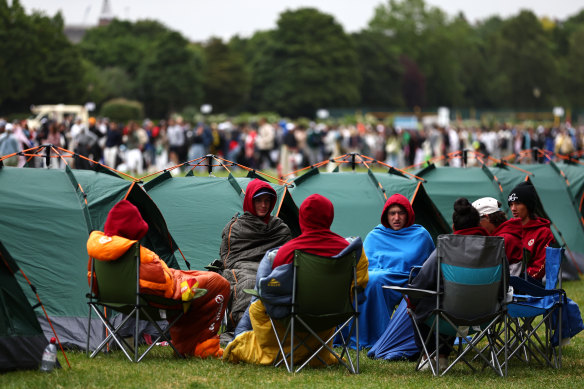
Spectators queue while outside their tents at Wimbledon Park.Credit: Getty Images
There are the usual in-your-face billboards and advertising from the time you step off the train at Wimbledon station, or arrive in any other way.
That is one of the few similarities with the vibe around Melbourne’s Australian Open, which is held in the heart of a heaving city, rather than tucked in an aristocratic suburb.
Otherwise, these two grand slams are wildly different beyond even the locales, starting with private club versus a tennis centre, and Wimbledon’s pure tennis focus contrasted with Melbourne Park’s increasingly eclectic fusion of tennis and festival entertainment.
If you are at the grasscourt major, you are there to watch tennis.
Australian Open boss Craig Tiley highlights another: “Melbourne has 5 million people within an hour’s driving distance, whereas London, Paris and New York [where the other majors are held] have 25 million.
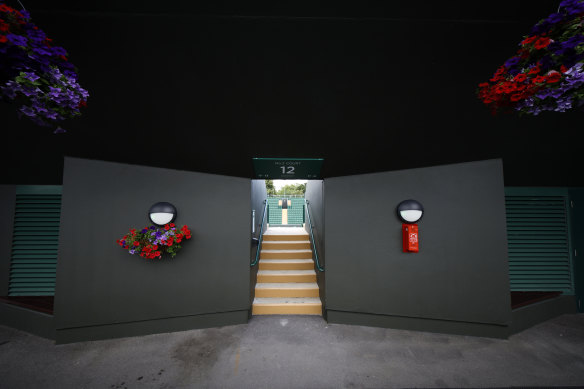
The steps leading up to Wimbledon’s No.2 Court.Credit: Getty Images
“We have a lot of the same people from Victoria come to our event because we have a smaller group we’re drawing from, so we’ve got to offer something very different. I put a challenge to the team that every year, our event has to be 50 per cent different than it was the year before.”
Among the placards this year are grand slam-winning Brit Emma Raducanu and world No.1 Jannik Sinner, while you cannot miss the 2024 Wimbledon slogan “Always like never before” splashed across the front of luxury department store Elys.
However, it is once you walk into Wimbledon Village that the romance, charm and spirit come to the fore.
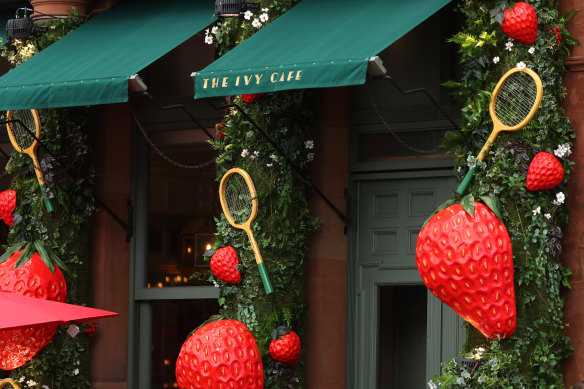
The Ivy Cafe in Wimbledon Village with its Wimbledon-themed exterior in all its glory.Credit: Getty Images
Almost every shop window adopts a tennis theme, from memorabilia, to creative ball designs, an assortment of wooden racquets, beautifully constructed and colourful flower arrangements, and even acrylic paint drawings.
The Dog and Fox pub, where Nick Kyrgios famously spent much of the night before his 2019 second-round clash with Rafael Nadal, is also on one of the corners in Wimbledon Village. Kyrgios even has his own presence in the Joe & The Juice window in a marketing collaboration.
The anticipation heightens as you begin the descent down the hill to the All England Lawn Tennis Club.
The queues are not as overwhelming as they once were, at least outside the actual AELTC, because only the actual ticket holders are visible.
The queue for tickets is now across the road at Wimbledon Park, with even that nostalgic experience transformed from Australian tennis great Mark Woodforde’s heyday as a player.
Tiley said this time-honoured tradition was about “the aspiration of getting into the grounds”. Tiley’s major, on the other hand, is all about accessibility and the digital age.
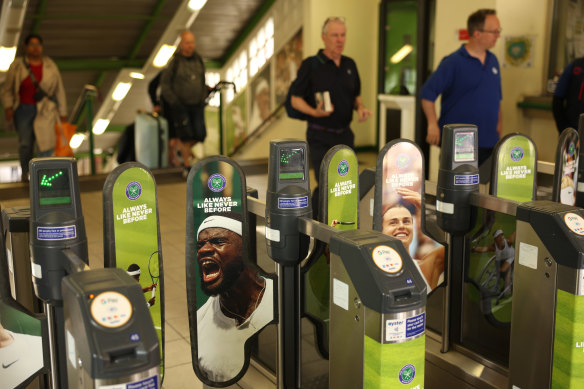
Tennis fans pour through the tennis-themed turnstiles at Southfields underground station in London.Credit: Getty Images
“The first few years I came, people were still lining up on the streets, and they had tents,” Woodforde told this masthead. “Now, they put [the queue] in the park, and you don’t necessarily get to see it. That was part of the charm, and you could feed off it.
“They were coming to watch you play, and were willing to line up for 24 to 48 hours ahead of time. They didn’t even know what ticket they were going to receive when they come in, or if they would get in the next day.
“They’ve created an eatery area over there now, so it is a bit more of a party atmosphere, or a camping or glamping atmosphere, with music, outlets and toilets.”
Nick Holloway, a Melburnian who now lives in London, waited seven hours in the queue one year.
“You’d think sitting on a piece of grass for that long before the tennis would be one of the most boring things in life, but it was quite a fun experience,” Holloway said. “Everyone loves tennis and is in a jovial mood, and there is this anticipation about the day.”
Walking through the gates
Woodforde, like many tennis fans before he became one of the star attractions in his own right, would stay up late as a kid during school holidays to tune into Wimbledon.
He said that experience was why – once he first competed at the London slam, in 1986 against American player-turned-coach Brad Gilbert – there was a “jolt of electricity” as he approached the club and then walked in.
Remarkably, nearly four decades later, the 12-time grand slam doubles champion – half of them won at Wimbledon, alongside the other half of the “Woodies”, Todd Woodbridge – still gets that feeling each year.
This year’s Australian crop are equally enamoured with wearing all white (although Kyrgios appeared on centre court two years ago in red Nikes and a red cap “because I do what I want”) and soaking in the tournament’s rich history.
Alex de Minaur labelled Wimbledon “iconic”, qualifier Olivia Gadecki used the word “magical” to describe walking through the AELTC gates, Adam Walton went with “very special”, and Rinky Hijikata said it was the major he most wanted to play.
“It’s a dream come true,” Hijikata said. “To me, it’s the most prestigious and important tournament in tennis. I feel like when you’re growing up, and you pick up a racquet, your dream is to win Wimbledon one day.”
The tennis-in-an-English-garden atmosphere is deliberate and spectacular, complete with the greenery living walls on the outside of the showcourts, with Wimbledon colour schemes of green, purple, mauve and white.
‘I want the Australian Open to be the event that we ask for forgiveness versus permission’
Australian Open boss Craig Tiley on his aspirations for the tournament
The AELTC can also lay claim to hosting the cleanest of the slams, with dedicated staff on high rotation to wipe down everything during the day, including even the railings that help separate the crowds on the grounds.
“They’ve put much more effort into the beautification of the grounds,” Tiley said.
“There is more permanent infrastructure, and I love their plans across the street [to expand into Wimbledon Park, with the development of 39 new tennis courts, including an 8000-seat showcourt]. Wimbledon traditionally haven’t discussed big plans for the future, but now they have.
“I actually congratulated both the CEO [Sally Bolton] and the chair [Debbie Jevans], to say that I’ve been coming here for many years, and this is the best I’ve seen the grounds look.”
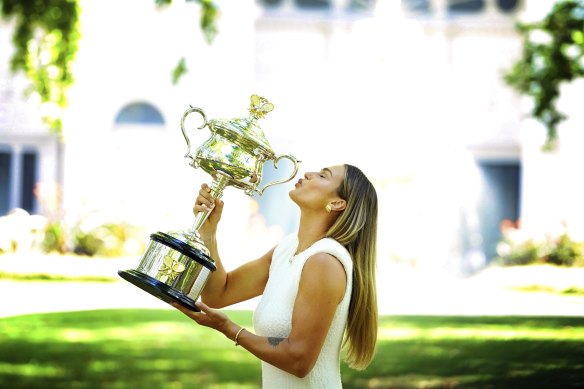
Aryna Sabalenka poses with the Daphne Akhurst Memorial Cup at the sun-drenched Carlton Gardens after her win in January.Credit: Luis Enrique Ascui
Every slam is unique
Tiley has transformed the Australian Open into a sporting and entertainment colossus.
A grand slam record attendance north of one million people attended the 15 days of the event this year – after it started on a Sunday for the first time – and more than 1.1 million across the three weeks, including “Opening Week”.
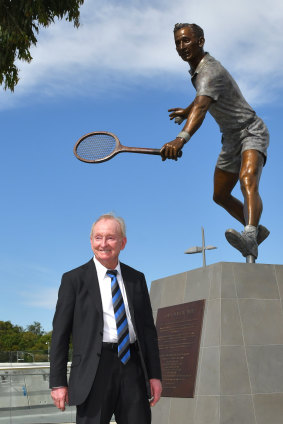
Australian tennis legend Rod Laver stands proudly alongside his statue at Melbourne Park.Credit: Fairfax Media
Fans could also enter each court after the end of every game rather than the traditional change of ends. It is these types of innovations and risks that Tiley’s AO prides itself upon.
“I want the Australian Open to be the event that we ask for forgiveness versus permission, and we will push it, we’ll take some risks, and we’ll be the first to say, ‘Sorry, that didn’t work out that well’,” Tiley said.
“The player experience will be different next year; a little bit on-court, as well as off-court. The fan experience will also be different ... the things the fans are going to see will be pretty cool as well.
“I push the team to think to the sky, and maybe we’ll land somewhere halfway in between, which will still be pretty good.”
There is some collaboration between the chiefs at all four slams, but each major has its own unique appeal. Colloquially, Woodforde said they were linked with their own loose theme: Australian Open (holiday), French Open (fashion), Wimbledon (history) and US Open (circus).
But Woodforde was quick to point out that Wimbledon, under Bolton’s leadership, was more willing to explore new ways of doing things.
That is something, perhaps, that the London leviathan is learning from the Australian Open. On the flip side, one experienced international journalist’s view on the AO was that he thought more could be done to recognise the game’s history, beyond the Garden Square busts of Australian legends.
“They’re the two best sporting events in the world,” Holloway said.
“They’re a fair bit above the US Open and Roland-Garros. I’ve been to all of them, and love them all, but the Aus Open has got the event side of it – I don’t think anyone in world sport does that as well – and Wimbledon has the historic side that no one can compete with.”
Marc McGowan is at Wimbledon with the support of Tennis Australia.
Watch Wimbledon 2024 from July 1 live and exclusively free on Nine and 9Now with every match streaming ad-free, live and on demand with centre court in 4K on Stan Sport.
News, results and expert analysis from the weekend of sport sent every Monday. Sign up for our Sport newsletter.